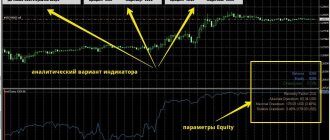olegas Apr 27, 2015 / 121 Views
In fact, in a greatly simplified form, the entire trading process can be reduced to two main components:
- Determining the size of the opened position;
- Completing a transaction (opening, holding and closing a position).
The decision on the size of the position to be opened falls entirely on the shoulders of such area of knowledge of the trader as Money Management. It is the money management rules developed by the trader and included in his trading system that should determine the percentage of risk that can be included in each specific transaction. And based on the acceptable level of risk for each position, its size is determined.
The rules for opening, holding and closing positions should also follow from the trader's trading system. It is the trading system that should provide answers to all questions that arise during the trading process. However, there are a number of simple rules that can be considered universal and suitable for most trading systems. These are the ones that will be discussed below.
What are the ways to close a position?
You can close a deal manually or automatically. The good thing about the manual method is that it is completely under your control. However, it has a significant disadvantage - you may not have time to exit the deal at the best price, either due to increased volatility, or simply miss the signal.
You can close a position automatically:
- by stop loss;
- by take profit;
- by trailing stop.
How and when to close a trade manually
Manual closing is optimal in two cases:
1. If your trading strategy assumes it, for example, when receiving a signal from an indicator.
2. If the price has not yet reached the take profit, but important news is expected in the market, and you want to take profit before volatility increases.
Well, if something goes wrong and the deal urgently needs to be closed, the manual method will help you.
To close a position in the MetaTrader4 or MetaTrader5 terminal, go to the “Terminal” table and find the desired deal in the “Trading” tab. Either click on the cross at the right end of the line, or right-click to call up the context menu and select “Close order” from it. In the window that appears, click the “Close” button.
How to close a position automatically
- This method is very convenient because it does not require the trader to monitor the transaction - the result will be recorded without his participation. That's a plus. However, here it is necessary to plan the transaction very carefully even before opening it.
- But sometimes the market situation can change. For example, unplanned news or expected news will come out, but different from the forecast. If before this moment the price has not reached the take profit, it will be possible to save at least part of the profit in the event of a sharp reversal in quotes only manually. This is a minus. Therefore, even when working with stop losses and take profits, trades should be monitored whenever possible.
How to close a position automatically? When opening a trade, immediately enter a stop loss and take profit in the order setting window. If the deal has already been placed without them, find it in the “Trade” tab of the “Terminal” table. Right-click the context menu and select “Modify or delete order” there. In the window that appears, enter the stop loss and take profit values. When the price reaches one of them, the position will be closed without your participation.
The trailing stop exit deserves special attention. This is a floating stop order that follows the price, and when it reverses, it turns into a standard stop loss. This method makes it possible to lock in maximum profit from price movements during high volatility and at the same time protect the transaction from risk.
IMPORTANT!
This method only works when the terminal is turned on.
Do you want to learn how to place stop orders correctly? Take the “Reboot from Gerchik” course! Find out more about the course
Each bank that engages in foreign exchange transactions has foreign exchange positions in each currency.
These may be requirements or obligations. If they are equal, then the currency position is closed; if they are not equal, then it is open. An open currency position can be short if liabilities exceed assets in that currency, or long if assets exceed liabilities. The foreign exchange position is the object of constant attention on the part of foreign exchange dealers to assess foreign exchange risks and financial results in the event of their closure at existing exchange rates. [p.725] In such a transaction, the seller of the option buys an option that is identical in all respects to the original one, with the exception of the premium. The unexercised option is then offset by the clearing corporation with the option purchased to cover the short position. In each case, the seller's or buyer's profit or loss is determined by the difference between the initial premium paid or received and the premium received or paid on the closing transaction. Closing a position by only one investor, either the seller or the buyer, has no impact on other investors. Thus, if the writer of a call option liquidates the position by closing, the owner of the option can nonetheless exercise the option at any time. [p.302]
For German marks, the net result on January 18 is a profit of 2,500 DEM, which, however, is almost completely offset by a loss of 2,000 DEM on April 18 (balance +500 DEM). In the case of reverse swap transactions, AAA Bank could have minus 500 DEM, but the main thing is that all positions are closed and the currency risk is neutralized. [p.41]
EXCHANGE POSITION - the state, position, amount of exchange contracts at a certain moment. A position in futures contracts or transactions on a futures exchange is called a forward position. If a forward position is closed by a reverse transaction or settlement is made on it, then it is called a closed position. If B.p. reflects the discrepancy between purchases and sales, the unrealized obligation of the seller and buyer, then it is called an open position. If the balance of futures contracts to buy is not covered by obligations in the real commodity market or contracts to sell, then a long position occurs. If the balance of futures contracts for sale remains uncovered, then a short position occurs. A type of stock speculation is positional speculation (the bullish game involves a long position, the bearish game involves a short position). [p.36]
CURRENCY POSITION CLOSED [p.44]
Under the Investment Services Directive (ISD), which came into force on 2 January 1996, the UK has the same publishing rules for UK and foreign securities. Data on all transactions in liquid European securities with a volume of up to six NMS are subject to immediate publication. Intermarket or other risk-free transactions carried out under orders are also subject to immediate publication; the same applies to illiquid European securities. Trades exceeding six NMS are published with a delay of up to 60 minutes. Large block trades of 75 NMS or more must be posted after five business days when the position is 90% closed or the firm is ready to disclose the information to the exchange. [p.57]
Positions closed by the current day. [p.323]
Positions closed by the current day have the following form [p.324]
The exchange rate at which the hedger enters into the contract is between the cash and futures rates and depends on the timing of the position's closure. If a futures position is closed immediately after it is opened, then the exchange rate of the transaction will be the spot rate, i.e. 1 f. Art. = 1 50 dollars. If the contract is held until the expiration date, then the established rate will be the futures rate on the day the contract is concluded, i.e. 1 f. Art. = = $1.485 Closing a position between these dates will allow you to get the exchange rate between the two extreme points, as shown in Fig. 8.1. The established exchange rate is a linear function of time. For example, if a futures contract is entered into at time t and the position is closed 4 months later, then the stated exchange rate will be £1. Art. = $1.49. [p.91]
Since the speculator has no underlying assets or liabilities to offset the futures position, the accounting for his trades is completely different. In relation to speculation, there are no problems with carrying forward profits and losses, since here they follow the simple rule of measuring them on a “mark to market” basis and immediately recognizing profits or losses in full. All this reflects the economic meaning of futures speculation, which is to make a profit. Profits or losses on such transactions are recognized immediately, regardless of whether the positions are closed. [p.202]
In the vicinity of point o in the Momentum window (point O on the price chart), its value moved from a negative zone to a positive one. Accordingly, the stock has entered an uptrend, and an investor using the Momentum reversal trading system should open a long position. Closing a long position with this approach occurs at the point where Moment crosses the zero line from top to bottom. This is point B (and the corresponding point B on the price chart). Due to the significant strength of the trend, the investor would receive 68% of the income from such an operation. Let's go further. The next point of opening a long position practically coincides with point b, where Momentum again entered the positive zone, and the closing point coincides with point d on the Momentum chart (respectively, with point D on the price chart). This operation would also be quite profitable for the investor. [p.269]
Another signal often used by traders is the condition of the indicator chart crossing the oversold line from bottom to top, which leads to the generation of an order to open long positions (closing short ones), as well as the condition of crossing the overbought line from top to bottom, which leads to the generation of a signal to close long positions ( opening short ones). Unlike signals for the formation of extrema, this signal does not have a leading property, but is rather confirmatory. Accordingly, the number of false signals is reduced. The disadvantage of using the RSI line crossing the oversold and overbought levels as a signal is the slight lag. And this, in turn, can lead to the loss of part of the accumulated profit when exiting the position. In Fig. 27.4, the corresponding entry and exit points are labeled d, e, f and g. Their corresponding prices are D, E, F and G. [p.275]
CLOSED POSITION - see CLOSED POSITION [p.540]
A bank's foreign exchange transactions are reflected in its foreign exchange position (the bank's claims and obligations expressed in foreign currency), which includes spot and forward transactions concluded at different rates and at different times. If there is equality of requirements and obligations, then the position is closed; in the absence of such equality, it is open and can be short, when obligations exceed requirements, or long, when requirements exceed obligations. In connection with ongoing foreign exchange transactions, the bank’s foreign exchange position also changes. Considering the scale of transactions, the bank’s corresponding division for foreign exchange operations keeps records of open foreign exchange positions (the so-called dealer position) using the latest computers. This position reflects unfinished transactions in specific currencies at a certain moment, without taking into account the timing of transactions as a result of which such positions appeared. [p.32]
The resulting balance is called a position. The position is closed if the balance is zero, and open if the balance is not zero. With a positive balance, i.e. the volume of requirements of this participant exceeds its obligations, the clearing participant is said to have an open long position. When the balance is negative, i.e., the clearing member owes more than is owed to him, the member is said to have a short position. [p.279]
Depending on the adopted strategy of behavior in the futures market and the cash market, the owner and seller of the option may be in different states, i.e. have an open (closed) position, and therefore have varying degrees of commercial risk. An open position in the spot market is the ownership of an asset (long position) or a commitment to deliver an asset at a future date (short position) in the futures market - buying a futures contract (long position) or selling a futures contract (short position). A covered position is a long (short) position in an asset covered by a short (long) position in the same or a substitute asset. [p.194]
The second line is to buy bonds on the cash market, the bond gives income F, at the end of the second period the position is closed. [p.246]
Open and closed weighted positions within each zone are determined. The amount of open weighted short positions is offset by the amount of open weighted long positions (and vice versa). The amount by which open short and long positions offset each other will constitute the closed weighted position of the zone. A short or long balance will constitute an open zone weighted position. In the event that a zone contains only open weighted long positions or only open weighted short positions, the closed weighted position for the zone is equal to zero [p.96]
As a result, on day X+W all positions were closed and the income was [p.175]
In the process of functioning, settlement and clearing activities went through two stages of development. At the initial stage, the clearing house takes on the functions of the organizer of trade execution. Based on the calculations performed, the requirements and obligations of each participant are determined. If the demands exceed the obligations, then this means that the participant must be paid. In this case, he is said to be in a long position. If the requirements are less than the obligations, then payment is expected from this participant, since he takes a short position. If the requirements are equal to the obligations, then the position is considered to be closed. [p.278]
Evaluation and analysis of the effectiveness of work to close unprofitable and unpromising mines is carried out from the position of each investor. The bulk of investment in closing unpromising mines usually comes from the federal (state) budget, but regional bodies and other interested organizations may also participate in this financing. In these cases, each of these investors fixes the effect they receive in the contracts they conclude (see 5.2). Let us list the main components of the budgetary effects and BE costs arising from the closure of unprofitable enterprises in the coal industry, which are taken into account when assessing the effectiveness of mine liquidation. [p.204]
The ratio of the bank's claims and obligations, including its off-balance sheet transactions, in foreign currency determines its foreign exchange position. If they are equal for a specific currency, the currency position is considered closed, and if they do not match, it is considered open. An open currency position can be short if liabilities and liabilities for the currency sold exceed assets and claims in it, and long if assets and claims for [p.349]
Let us assume that, starting the day with a closed position in all currencies, the bank carries out the following transactions during the day (Table 8.2). [p.350]
An assessment of the possible result of closing a position is achieved by recalculating all amounts of long and short positions into the national currency at the current rate at which transactions can be covered, taking into account the delivery time of currencies for forward transactions. More often, this recalculation is carried out in two stages: first, all positions are recalculated into the most common currency, for example the dollar, then the dollar amounts or their result are converted into the national currency. The economic result of both methods is the same. [p.351]
An indicator that measures relative closing price positions by comparing price fluctuations over a selected period. Typically %K (unsmoothed) and %D (smoothed) are used. [p.223]
In addition, beginners often do not have the patience to wait for important levels, and they exit the market a little ahead of time. After a losing position is closed, prices reverse in the predicted direction. But this reversal in the direction that the novice trader expected is already happening without him. This situation is further aggravated by the fact that novice traders work with small capital, which may prevent them from waiting for this reversal, since margin all will occur. [p.181]
Trading rules and ideas are scattered throughout this book. Winning ideas include making it easier to enter and exit positions, closing losing positions at the end of the day, and not trying to buy at the low. Many traders will benefit from these ideas. Many additional rules can be found or studied by reading Memoirs of a Stock Speculator Edwin Lefebvre. There are many good teaching iz- [p.202]
The following describes the four most common groups of option strategies: open positions, closed positions, spreads and combinations. In all charts, the X axis is the stock price, and the Y axis is the value of the option or portfolio. [p.102]
Total — total number of trades (a trade is considered to be a pair of opening a position and closing a position) [p.148]
The next trading day, March 6, the sale did not resume. The Dow jumped more than 125 points and more than made up for its decline the day before. While the Nasdaq 100 didn't erase its losses from the previous day, it still advanced 3.22 percent. If I had not been so concerned by the strength of the tech sector's selling on Thursday, I would have followed my routine trading discipline and immediately re-entered the market before Friday's close. This would be consistent with my Friday-Monday model, where extreme force on Friday would be followed by additional force on Monday. However, I waited until Monday, March 9th before re-opening the positions closed on March 5th. [p.156]
The general results of the first decade in the development of the oil and gas industry in Libya indicate that due to the indecisive, conciliatory position of the royal regime, due to its class nature and dependence on the West, it was not possible to realize the advantages associated with the high quality of Libyan raw materials and the favorable geographical location of its sources. On the contrary, concessionaire companies took full advantage of these factors, especially in connection with the closure of the Suez Canal and the high conditions of the freight market after the Arab-Israeli war of 1967, as well as the increased requirements of most developed capitalist countries for environmental protection, which increased for a certain period demand for low-sulfur grades of light oil. [p.58]
Despite the modification of a number of their articles in accordance with the Franco-Algerian Oil and Gas Agreement of 1965, the inherently unequal concession practice has not undergone fundamental changes. The financial conditions for the exploitation of Algerian oil and gas resources by foreign capital have approached the level of the oil-exporting states of the Middle East, but still remain noticeably less profitable for the North African concessionaire. Thus, the average (unweighted) revenues to the Algerian budget from each barrel of oil exports in 1966-1969. were inferior to more than 26% of Iraq's revenues for the same period (calculated according to Appendix, Table 1). In reality, the lag was greater given the superior quality of Algerian raw materials and especially its proximity to the Western European market. The importance of this geographical position increased sharply due to the closure of the Suez Canal in 1967. Within the strict framework of the Franco-Algerian agreement, these advantages were enjoyed exclusively by concessionaire companies. Repeated initiatives by Algeria to bring the contractually established payment system in line with significant changes in the market situation were met first with obstruction, and then with deliberately unsatisfactory counterproposals from the French side. [p.69]
MOBILITY - social a category denoting the transition of people from one social group, layer (professional, religious, class, etc.) to another. The term “M.” introduced by Russian sociologist Pitirim Sorokin (1889-1968). Social M. can act in different forms; promotion to positions with higher income, status, prestige, and power is called social. ascent, and movement to lower social. positions - social descent. This kind of movement (ascent-descend) is called vertical M. Movements within the same layer, without changing social. positions are called horizontal M. Soc. movement can also be carried by ter. character. The concept of “social M.” (and its varieties) are used in studies of social typology. communities (for example, closed society, totalitarian, open society, democratic), social. structures and dynamics of social structures. [p.181]
The result of a currency position is positive for the bank if it held a long position in a currency that has appreciated. However, this gain can be fully realized only by closing all currency positions at current rates. This operation is called profit realization (profit = taking) and usually occurs during periods of active changes in the exchange rate, stopping its movement, and sometimes temporarily changing its dynamics in the opposite direction. [p.351]
Foreign exchange transactions with immediate delivery are the most mobile element of a foreign exchange position and involve a certain risk. The technique for performing them includes several stages. Before the foreign exchange markets of a given country begin to operate, dealers become familiar with the closing rates of the previous day in markets that close after the end of the trading day. Thus, the foreign exchange market in New York, due to the time difference, operates for another 5 hours after the closure of Western European currency markets. In addition, dealers analyze the movement of exchange rates in markets that open earlier (for Western Europe - Tokyo, Hong Kong1, Singapore, Bahrain), studying the reasons for their changes, events, including expected ones, that may affect exchange rates. Finding rates relative to critical points in graphs of changes in currency exchange rates to the dollar (the so-called charts) is also of considerable importance. Key rates have been historically and statistically determined, after which the currency enters a new zone of exchange rate changes. On this basis, dealers, taking into account their existing currency position, use a computer to determine the average exchange rate of their currency against foreign currencies. This course is necessary for the first transactions with banks and companies in your country. [p.353]
How to close part of a position on Forex
We will separately consider how to close part of a position in MT4 and MT5. Partial closing is appropriate when a trader wants to take the maximum price movement and at the same time minimize risks. In this case, if a transaction is opened with a divisible volume, you can exit it step by step.
How to close part of a position in MT4 and MT5 technically
1. Find the deal in the “Trade” tab of the “Terminal” table. 2. Open the context menu and select “Close order” there. 3. In the window for manually closing an order there is a “Volume” column. Select the one you want to close. Part of the profit is fixed. The remaining lots remain in operation.
Step-by-step exit from a position: making profit in small portions
The phased exit method can be combined with the strategy we discussed above. Use it when you are not sure that the price will continue to move in the desired direction. The strategy is as follows:
Open a position, wait for the expected price peak, set a sliding stop-loss, withdraw part of the profit to ensure that the transaction breaks even. Then all that remains is to relax and wait.
From a game theory perspective, the phased exit approach is completely disadvantageous compared to the other strategies described. It reduces the mathematical expectation of profit by half. Why use it then? The key advantage of the strategy is that the trader is relieved of psychological stress. Don't underestimate the pressure factor at the initial stage.











